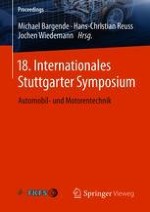2018 | OriginalPaper | Buchkapitel
Measures to fulfill
verfasst von : Dirk Naber, S. Bareiss, A. Kufferath, M. Krüger, H. Schumacher
Erschienen in: 18. Internationales Stuttgarter Symposium
Verlag: Springer Fachmedien Wiesbaden
Aktivieren Sie unsere intelligente Suche, um passende Fachinhalte oder Patente zu finden.
Wählen Sie Textabschnitte aus um mit Künstlicher Intelligenz passenden Patente zu finden. powered by
Markieren Sie Textabschnitte, um KI-gestützt weitere passende Inhalte zu finden. powered by
The first stage of the regulations on real-driving emissions (RDE) has become effective in Europe in September 2017. Now compliance with the EU6d_temp stage is required in order obtain a type approval. This regulation aims to limit the nitrogen-oxide and particulate emissions. With residual emissions from diesel cars having only very small contribution to finedust in cities due to the broad-based use of particulate filters, further development activities are now geared towards effectively limiting nitrogen-oxide emissions.For several years Robert Bosch GmbH has been conducting comprehensive studies in order to support OEMs in meeting the emission targets by defining technical measures that will effectively limit and reduce real-driving emissions. Respective progress reports were presented at the previous FKFS conferences in 2016 /1/ and 2017 /2/. At last year’s symposium we were able to demonstrate that the requirements of the EU6d_final stage applicable as of 2020 (new types) and 2021 (all types), respectively, can be met in particular through an intelligent combination of engine-related measures and exhaust-gas after-treatment. This year’s presentation focuses on further improvements for remaining emission-related driving modes and on the increased emission robustness even during driving maneuvers which can hardly be considered ″normal driving″.This paper demonstrates that undercutting the limits set forth in the EU6d_final stage with a high degree of robustness is possible through a further optimization of the interaction between the engine and the exhaust-gas after-treatment and in particular by an improved temperature management of the exhaust-gas after-treatment system. The improvements over the status presented last year /2/ can be achieved without any additional hardware. Furthermore, approaches to further optimize the emission behavior will be discussed.As the studies had not been finalized when this paper was written, some of the following results are preliminary that may be updated during the oral presentation.
